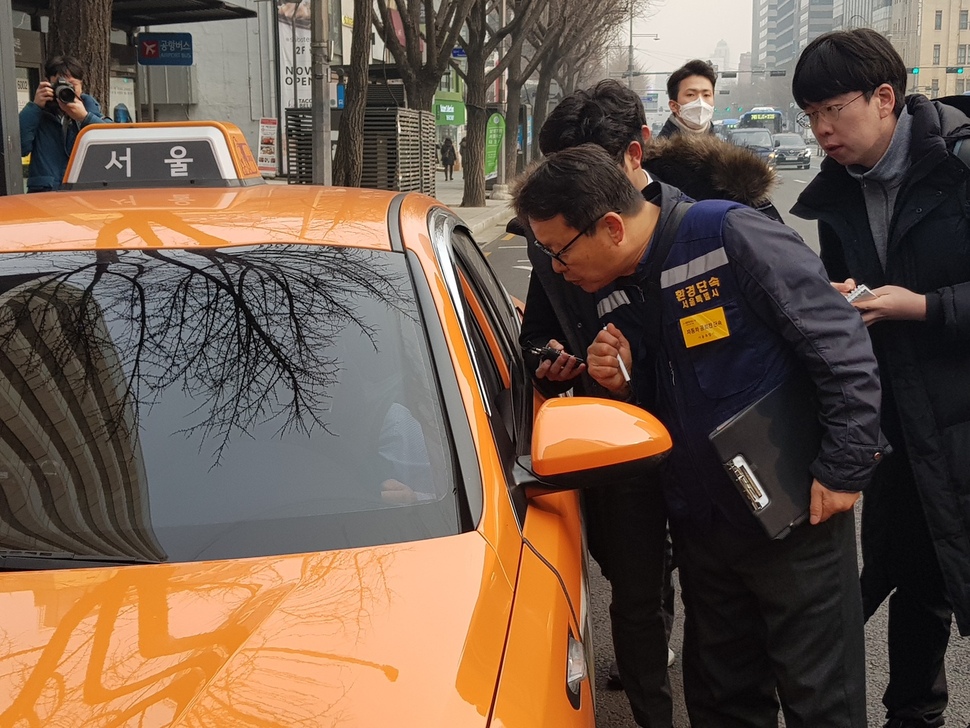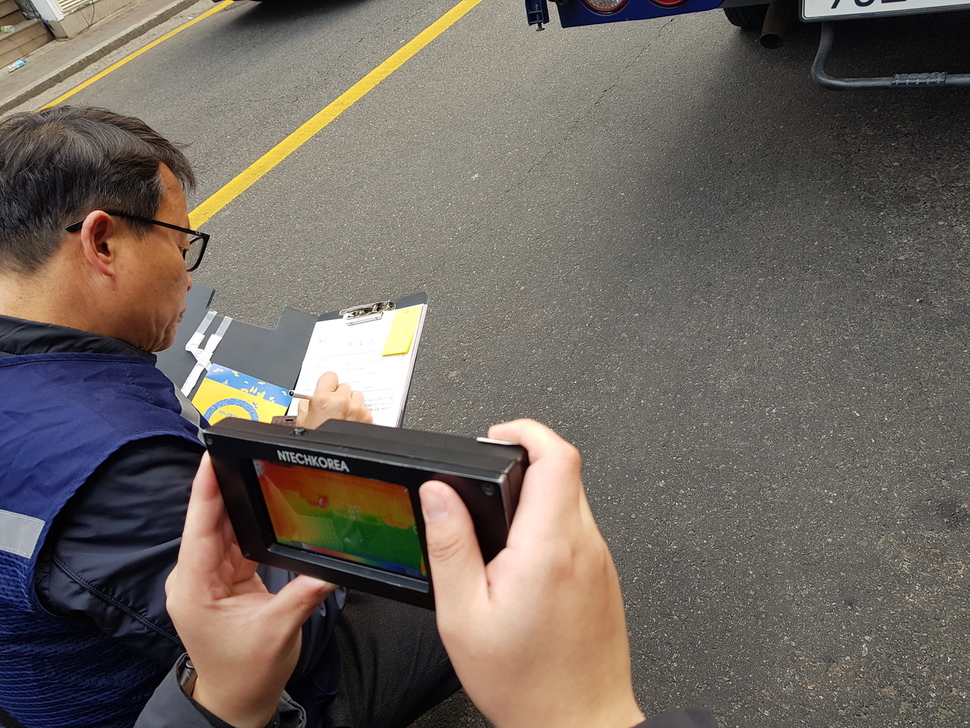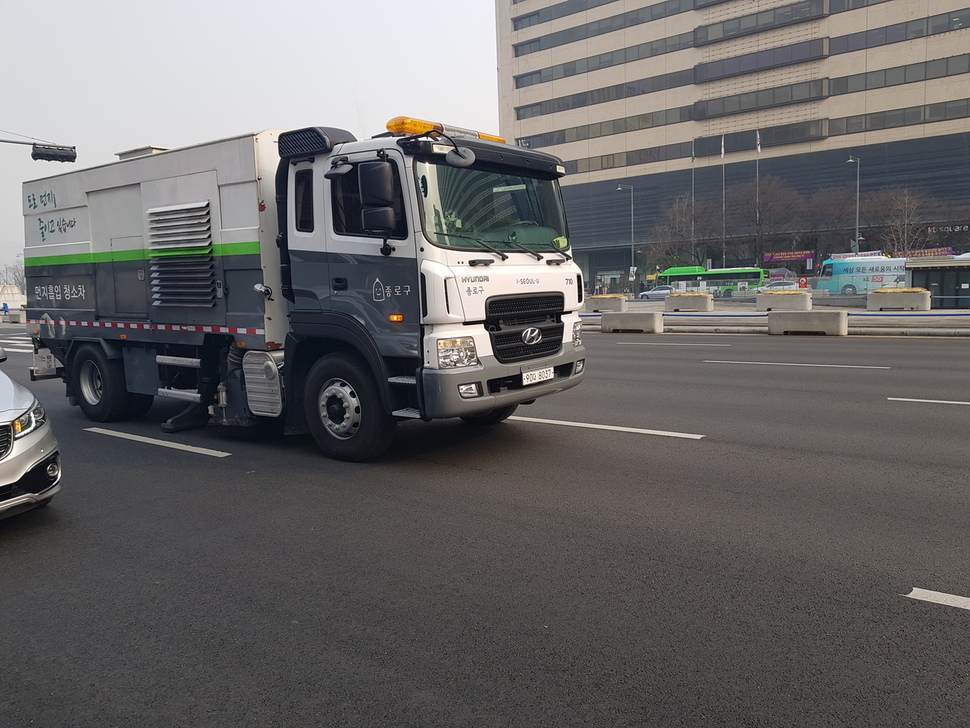Posted on : Jan.15,2019 17:37 KST
 |
|
City officials crack down on engine idling throughout the greater Seoul area as part of an emergency measure to reduce fine particle pollution. (Chai Yoon-tae, staff reporter)
|
Emergency particle pollution reduction measure implemented for 3 straight days
The city of Seoul implemented street cleaning efforts and a crackdown on idling vehicles on Jan. 14 as a measure to reduce fine particle pollution following the declaration of a second straight day of emergency reduction actions for the greater Seoul area.
Observing a large tour bus idling its engines while awaiting passengers at parking facilities for Gyeongbok Palace – designated as a site for intensive idling crackdown that day – officials with the city’s vehicle pollution and idling vehicle policing teams immediately examined the vehicle’s exhaust pipes with a thermal imaging detector. Once the heat was measured as evidence of a running engine, the officials began writing out a document confirming the vehicle to have been idling. Seeing this from the distance, the driver ran over to turn off the engine. No penalty was issued, as the vehicle was determined to have been idling for less than five minutes.
According to the Clean Air Conservation Act, drivers are allowed to idle their engines for up to two minutes at a time under atmospheric temperatures of five degrees or more; in cases of temperatures between zero and five degrees, up to five minutes of idling is permitted. The temperature around 2 pm, when the officials spotted the bus and took action, was three degrees. That day, around 20 members of the city’s idling vehicle policing team split into seven teams to crack down on idling vehicles at parking facilities near the city’s four major gates, near schools, and around the city’s palaces.
 |
|
City officials use thermal imaging technology to determine how long an engine has been idling. (Chai Yoon-tae, staff reporter)
|
Among the gases released by idling vehicles are nitrogen oxides (NOx), which are implicated in fine and ultrafine particle dust. The effects on the atmosphere are particularly severe on days when fine dust concentrations are high, as was the case on Jan. 14. This was the reason for the officials’ urgency. Over the 50 or so minutes that the Hankyoreh accompanied them, the team spotted a total of eight idling vehicles; in each case, the driver immediately turned off the engine and was not fined. On Jan. 13, fines were issued for two of 480 total vehicles found idling, the city reported.
With 85 dust-absorbing “cleaner vehicles” in operation since the day before, the city continued its efforts on Jan. 14 to clean dust from the streets. The special vehicles are not able to remove fine particulars from the air, but are used to ensure that dust on the roads and rubber fragments from tire abrasion do not become airborne.
The Ministry of Environment ordered emergency reduction measures affecting the entire greater Seoul area for a third straight day on Jan. 15. It is the first time in history that the measures have been implemented for three days running. When emergency reduction measures are in effect, all “outdated diesel vehicles” weighing 2.5 tons or more registered with the cities of Seoul and Incheon and Gyeonggi Province before 2005 are barred from operating in Seoul.
The city is also implementing a full-scale shutdown of parking facilities for public institutions within the city and suspending use of around 33,000 official vehicles. Once the Special Act on the Reduction and Management of Fine Particle Dust goes into effect on Feb. 15, the guidelines will change to bar operation by vehicles with a “level 5” exhaust gas rating.
 |
|
A dust-absorbing vehicle cleans the streets of downtown Seoul. (Chai Yoon-tae, staff reporter)
|
Ultrafine particle dust concentration reach worst levels to go on record
Ultrafine particle dust concentrations around the Korean Peninsula on Jan. 14 were the most severe since official bulletins were introduced in 2015. The situation is the result of high concentrations of ultrafine dust arriving from outside while domestic atmospheric conditions remain stagnant. According to Air Korea (Korea Environment Corporation) data on atmospheric pollution, average daily ultrafine dust (PM2.5) concentrations as of 8 pm on Jan. 14 totaled 126㎍/㎥ for Seoul, 124㎍/㎥ for Gyeonggi, and 106㎍/㎥ for Sejong.
By Chai Yoon-tae and Park Ki-yong, staff reporters
Please direct comments or questions to [english@hani.co.kr]











